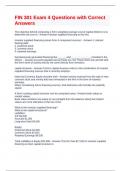FIN 301 Exam 4 Questions with Correct
Answers
The objective behind computing a firm's weighted average cost of capital (WACC) is to
determine the cost of - Answer-investor supplied financing to the firm.
Investor supplied financing comes from 4 component sources: - Answer-1. interest
bearing debt
2. preferred stock
3. common stock
4. retained earnings.
Spontaneously generated financing like ______ and _______ _______ included in the
WACC. - Answer-accounts payable and accruals are not; These items rise and fall with
the firm's level of activity and do not come directly from investors.
capital structure - Answer-A firm's capital structure refers to the combination of investor
supplied financing sources that it currently employs.
Note that Common Equity includes both - Answer-money received from the sale of new
common stock and money that was reinvested in the firm in the form of retained
earnings.
When considering future financing sources, that distinction will normally be explicitly
stated.
A firm's existing capital structure can be computed using - Answer-book values or
market values.
Book value numbers are easier to use (straight from the balance sheet) but market
values are more indicative of the true costs.
What is the investor supplied financing?
What is the capital structures?
Liabilities:
A/P $3,000
Accruals $1,500
Long-term Debt $4,500
Equity:
Preferred Stock $1,000
Common Stock $7,500
Retained Earnings $4,500
Total Liabilities & Equity $22,000 - Answer-This firm has $17,500 in investor supplied
financing so their capital structure is:
,Debt 25.7%
Preferred Stock 5.7%
Common Equity 68.6%
Total - 100.0%
When considering future financing, it is the firm's _____ that is most important. -
Answer-target capital structure
The target capital structure refers to the combination of - Answer-debt, preferred stock,
and common equity that the firm plans to use to finance future projects.
The target capital structure is based on the idea that there is a - Answer-single optimal
combination of financing sources that will minimize the firm's financing costs and
maximize firm value. The firm will attempt to obtain financing from the various
component sources in proportions that match this optimal combination.
Note that a firm is never sure if their target capital structure is really - Answer-the lowest
cost or optimal combination. Most firms believe that it is and proceed accordingly.
Rd - required rate of return - Answer-The interest rate on the firm's new debt. This is
normally estimated by computing the yield to maturity on the firm's existing bonds. Since
debt is tax deductible, this also represents the before tax cost of debt to the firm.
Rd(1-T) - Answer-This is the after tax cost of debt to the firm, where T is equal to the
firm's marginal tax rate. Note that the (1-T) represents the percentage of the firm's
before tax cost that the firm must pay.
Rp - Answer-from the firm's point of view, it represents the component cost of preferred
stock. Since preferred stock dividends are not tax deductible, there is no tax adjustment.
Rs - Answer-here we are looking at it from the firm's perspective so this represents the
firm's component cost of common equity raised by retained earnings. This type of equity
is also referred to as internal equity.
Re - Answer-This is the component cost of common equity raised by issuing new
common stock. Since there are flotation costs associated with issuing new shares of
common stock, this will be more expensive than common equity raised by retained
earnings. This type of equity is also referred to as external equity.
wd - Answer-Target weight or target percentage of debt in the firm's capital structure.
wp - Answer-Target weight or target percentage of preferred stock in the firm's capital
structure.
, wc - Answer-Target weight or target percentage of common equity in the firm's capital
structure.
WACC = The firm's weighted average cost of capital - Answer-WdRd(1-T) + WpRp +
WcRs
The assumption here is that all new common equity will be raised through retained
earnings. - Answer-If new common stock is required, we would add another term
(WeRe)
Consider two firms -
FIRM A
EBIT 10,000
Interest exp. -3,500
=
EBT 6,500
Taxes (30%) 1,950
=
Net Income 4,550
FIRM B
EBIT 10,000
Interest exp. -0.00
=
EBT 10,000
Taxes (30%) 3,000
=
Net Income 7,000 - Answer-Firm A has borrowed money and must pay interest on the
outstanding balance. Firm B has no debt and pays no interest.
Firm A pays $3,500 in interest, yet their net income is only $2,450 - Answer-less than
Firm B, who paid no interest.
The difference of $1,050 represents the tax savings from debt to Firm A. In other words,
because Firm B - Answer-paid no interest, they are obligated to pay $1,050 MORE in
taxes than Firm A.
We can calculate this tax savings by simply multiplying the firm's tax rate times its
interest expense: - Answer-1,050 = .30 (3,500).
So, if 30% of the interest paid is recovered in the form of lower taxes, the actual cost of
the debt is the remaining 70% of the interest that the firm paid. In other words, the cost
is: - Answer-= 3,500 (1 - .3)
= $2,450
Firm A:




